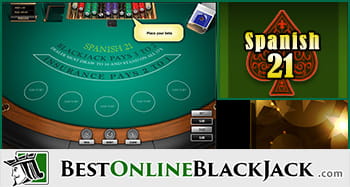Spanish 21 Game
Spanish 21 is a variation of one of the most iconic casino games, Blackjack. Spanish 21 offers some new and interesting changes that shift the dynamic of the game, one of which is the removal of all number ‘10’ cards from the deck. This leaves the dealer with decks of 48 cards, rather than 52. As one might expect, Spanish 21 uses the Spanish deck, which is simply a normal deck with all of the tens removed. There are several rule variations for this game, especially as it is a popular game played in brick-and-mortar casinos all over the U.S.A., so it is important to understand what the house rules are and how they may affect the house edge.
Blackjack Variations > Spanish 21
Spanish 21 Blackjack is a tougher, more intense game, especially since the House’s advantage and edge increases by 2%. However, this is thankfully offset by several extra bonuses and some higher payouts in the game.
It is a game that has grown in popularity, and currently found in every offline casino, but not so much so for online casinos yet.
Spanish 21 Rules
As all other blackjack game variations, it follows some similar characteristics of blackjack, such as the point value, the goals, and terminology, but like all variations, it has its little differences and extra twists:
The first difference and most noticeable one is the fact that 10’s are not used, which is what gives the House the extra advantage. You still have the Jacks, Queens, and Kings, but no 10’s.
Doubling down is only allowed after getting a hit and/or a split – with any card and hand. If the player doubles down, however, he/she must double the same bet amount originally made at the beginning. Players can also split up to 4 hands
Players can surrender on any hand against the dealer, except if the dealer gets blackjack or 21. By surrendering, they will get half their bet amount back.
Players can also surrender after doubling-down, which will give them back the double down bet, but they will lose the initial bet.

Players will always win with a 21 – regardless of the dealer’s hand. Insurance can be purchased too, and it pays out 2:1.
Lastly, you can do two side bets: a Super Bonus bet where if you get three 7’s, and the dealer’s face-up card is also a 7, then you’ll get $1,000 on $5-$24 bets and $5,000 on $25 bets. The other side bet consists of betting that your hand will outrank that of the dealers, in which payouts could go up to 40:1.
How to Play Spanish 21
Clearly, Spanish 21 is quite similar to regular blackjack… all you have to remember is that you have ‘rescue’ or ‘surrender’ options. You also will have no 10’s, so remember the advantage on the House, and last major difference is the addition of bonuses and higher payouts, but let the dealers worry about that since they remember all those payouts – unless you wish to learn them by heart -.
Make your initial bets and side bets if desired. Get your cards, and either surrender, split, double, hit, or stand. Once you compare with the dealer’s hand, you’ll be able to see if you have lost, pushed, or won the hand. The dealer should let you know about the bonuses and payouts if you can’t remember.
Spanish 21 Hand Examples
The most important hand examples to remember would be the bonus hands, which are the only extra payouts compared to regular blackjack:
* Blackjack pays 3:2
* Insurance as seen above, pays 2:1
* 5-card 21 (getting up to 21 with a combination of 5 cards dealt) pays 3:2
* 6-card 21 pays 2:1
* 7 or more card 21 pays 3:1
* 21 made-out of a 6, 7, and 8 suited pays 2:1
* 21 made-out of a 6, 7, and 8 mixed-suit pays 3:2
* 21 made-out of a 6, 7, and 8 spades pays 3:1
* 21 made out of three 7’s mixed suit pays 3:2
* 21 made out of three 7’s suited pays 2:1
* 21 made out of three 7’s spades pays 3:1
If however, the player doubles down, then he/she will not be eligible for the bonus.
Video Tutorial
Free Online Spanish 21 Game
